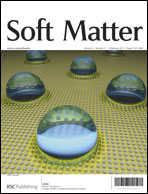N-Like rheograms of suspensions of magnetic nanofibers
Abstract
Rheograms of suspensions of single-domain magnetic nanofibers in the presence of an applied magnetic field display an N-like shape. Namely, the shear stress initially increases with the shear rate, reaching a maximum at values of the shear rate of the order of 10 s−1, then decreases to a minimum and, finally, increases monotonically as the shear rate is further increased. In this paper we present a theoretical model that explains this shape of the rheograms from a microscopical viewpoint. Our model considers that two types of nanofiber aggregates of ellipsoidal shape are built upon magnetic field application, depending on the strength of solid friction between nanofibers in each type of aggregate. In the first type of aggregate, interfiber friction is not very strong and nanofibers could reorganize as the aggregate is tilted by the shear flow, giving rise to a “paramagnetic” aggregate with changeable magnetization. In the second type of aggregate, interfiber friction is so strong that nanofiber orientations are fixed and, thus, the magnitude and direction (along the aggregate main axis) of the magnetization of the aggregate are fixed too. This model is a simplification of the real situation in which a more or less continuous distribution of the aggregates over the friction forces is expected. In spite of this simplification, the predictions of our model agree qualitatively and quantitatively with experimental results.


 Please wait while we load your content...
Please wait while we load your content...